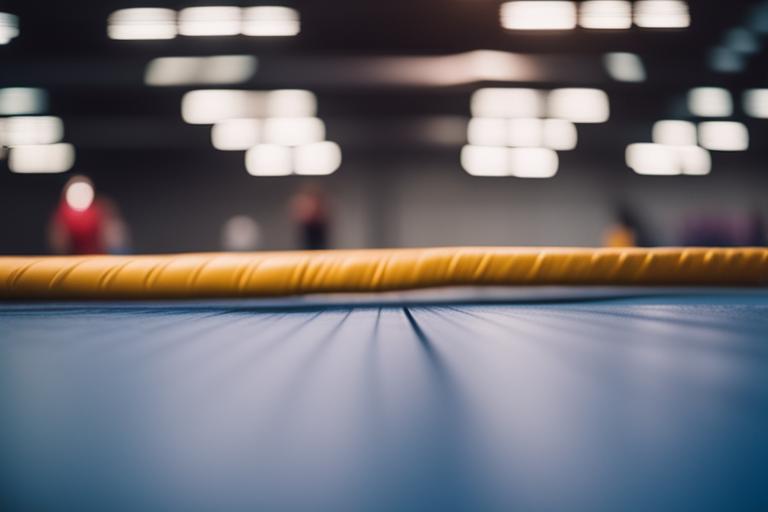Are you aware of the risks associated with trampolining? Trampolines can be a fun way to exercise and enjoy the outdoors, but they can also be the cause of serious injuries if safety guidelines are not followed. In this guide, we will provide you with everything you need to know to avoid common trampoline injuries.

How to Avoid Common Trampoline Injuries
Learn how to avoid common trampoline injuries by understanding the risks, identifying symptoms, and taking preventive measures.
– Common trampoline injuries include ankle sprains, fractures, head and neck injuries.
– Trampoline injuries are caused by factors such as age, weight, and ability, as well as incorrect set up and unsupervised jumping.
– Preventive measures include following safety guidelines, using safety nets, supervising children, and limiting the number of people on the trampoline at once.
Common Trampoline Injuries and Symptoms
Trampoline injuries can range from minor sprains and fractures to more severe head and neck injuries. Ankle sprains and fractures are some of the most common injuries associated with trampolining. Symptoms include pain, swelling, and difficulty bearing weight. Head and neck injuries can be more severe and include symptoms such as headache, dizziness, confusion, and loss of consciousness.
According to the American Academy of Pediatrics, there were approximately 100,000 trampoline-related injuries in the United States in 2019. To prevent these injuries, it’s crucial to understand what causes them and take preventive measures.
What Causes Trampoline Injuries
Trampoline injuries can be caused by improper use, age, weight, and ability. Using a trampoline that is not set up correctly, using a trampoline that is too small or too old, and jumping on a trampoline without proper supervision can increase the risk of injury. Children under six years old are at a higher risk of injury due to their developing bones and lack of coordination. Additionally, heavier individuals are at a higher risk of injury due to the increased force placed on the trampoline. Individuals with a history of back or neck problems should avoid trampolining altogether.
Understanding these risks can help you take preventive measures to avoid common trampoline injuries.
| Preventive Measures | Description |
|---|---|
| Follow safety guidelines | Follow all safety guidelines when using a trampoline. This includes using a safety net and ensuring the trampoline is set up correctly. |
| Supervise children | Supervise children while they bounce, and limit the number of people on the trampoline at once. It’s recommended that only one person jumps on the trampoline at a time. |
| Use protective gear | Encourage the use of protective gear such as helmets and pads can also significantly reduce the risk of injury. |
| Avoid dangerous behavior | Do not do somersaults or flips on the trampoline, as these can result in serious injuries, particularly to the head and neck. Additionally, avoid double bouncing, which occurs when one person jumps just as another person lands on the trampoline. |
| Jump off the trampoline | Avoid jumping off the trampoline, as this can result in serious injuries. |

Preventive Measures
To prevent trampoline injuries, follow all safety guidelines when using a trampoline. This includes using a safety net and ensuring the trampoline is set up correctly. Using a safety net can significantly reduce the risk of injury by preventing falls off the trampoline. Additionally, supervise children while they bounce, and limit the number of people on the trampoline at once. It’s recommended that only one person jumps on the trampoline at a time.
Encouraging the use of protective gear such as helmets and pads can also significantly reduce the risk of injury.

Safety Rules
Following safety rules is crucial when using a trampoline. Avoid doing somersaults or flips on the trampoline, as these can result in serious injuries, particularly to the head and neck. Additionally, avoid double bouncing, which occurs when one person jumps just as another person lands on the trampoline. This can cause the person on the trampoline to lose control and fall off.
Ensure that a responsible adult is present at all times while children are using the trampoline. Jumping off the trampoline should be avoided, as this can result in serious injuries.

Trampoline Maintenance
Proper trampoline maintenance is crucial to preventing injuries. Check the trampoline for wear and tear regularly, including the springs, mat, and frame. Ensure that the frame is secure and replace worn-out parts as needed.
Personal Stories
Trampoline injuries can be life-changing, and it’s essential to understand the real-life impact they can have. One individual who sustained a trampoline-related injury shared their story, “I was jumping on a trampoline with some friends, and we were doing flips and somersaults. I landed awkwardly and ended up fracturing my ankle. It was a painful experience, and I had to wear a cast for several weeks.”
Personal stories can help readers better understand the importance of following safety guidelines when using a trampoline.
Personal Story: Overcoming Fear of Trampolines
Growing up, Sarah was always afraid of trampolines. She never understood how people could jump so high and land without getting hurt. It wasn’t until her friends convinced her to try jumping on a trampoline that she realized how much fun it could be.
Despite her initial fear, Sarah found that jumping on a trampoline was exhilarating and fun. However, she soon learned that trampolines could be dangerous if not used properly. One day, while trying to do a backflip, she landed awkwardly and sprained her ankle.
After her injury, Sarah realized the importance of following safety guidelines when using a trampoline. She learned to stretch before jumping and to always have someone supervise her. She also made sure to wear protective gear like a helmet and pads.
Now, Sarah is an avid trampoline jumper and even teaches her nieces and nephews how to use a trampoline safely. She knows that trampolines can be a fun way to exercise and spend time with loved ones, but only if you prioritize safety.
Expertise
Understanding the physics behind trampolining can help you avoid common trampoline injuries. When you bounce on a trampoline, the force of the bounce is distributed across the trampoline, which can impact the risk of injury. Additionally, there are different types of trampolines available on the market, and choosing the right one for your needs is essential.
What to do in Case of Injury
If you or someone else sustains an injury while trampolining, it’s essential to take immediate action. First aid tips for treating injuries sustained from trampolining include applying ice on the affected area, taking painkillers, and resting the injured area. If the injury is severe, seek medical attention immediately.
Conclusion
Trampoline injuries can be prevented by following safety guidelines, encouraging the use of safety gear, and proper trampoline maintenance. Remember to prioritize safety when using a trampoline, and encourage others to do the same. By understanding the risks associated with trampolining and taking preventive measures, you can avoid common trampoline injuries and enjoy the benefits of trampolining safely.
Questions
Q.Who is most at risk for common trampoline injuries?
A.Children and teens are most at risk for trampoline injuries.
Q.What are some common trampoline injuries?
A.Sprains, fractures, and head injuries are common trampoline injuries.
Q.How can I prevent trampoline injuries?
A.Supervise children, use safety nets, and limit trampoline use.
Q.What if my child insists on using the trampoline?
A.Set clear safety rules and ensure they are followed at all times.
Q.How do I know if an injury requires medical attention?
A.Seek medical attention for severe pain, swelling, or loss of function.
Q.What are some long-term effects of trampoline injuries?
A.Chronic pain and joint problems can result from trampoline injuries.
Follow us!!